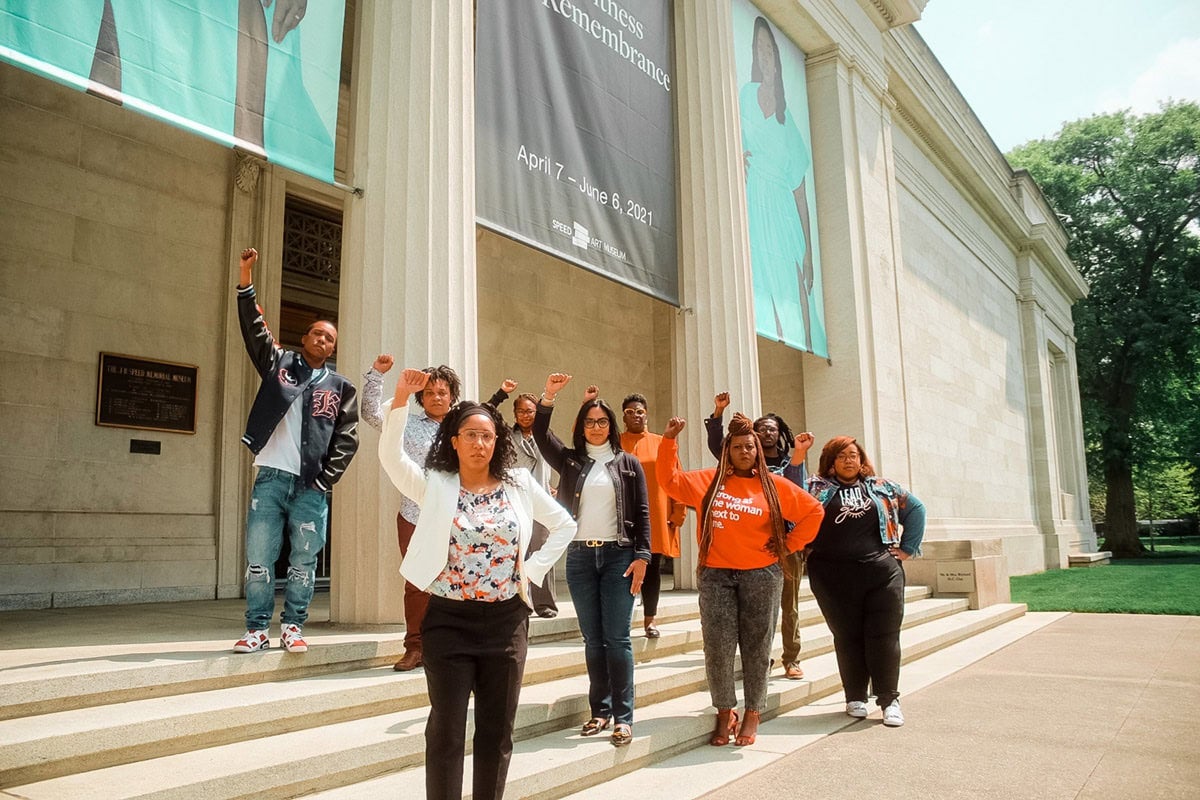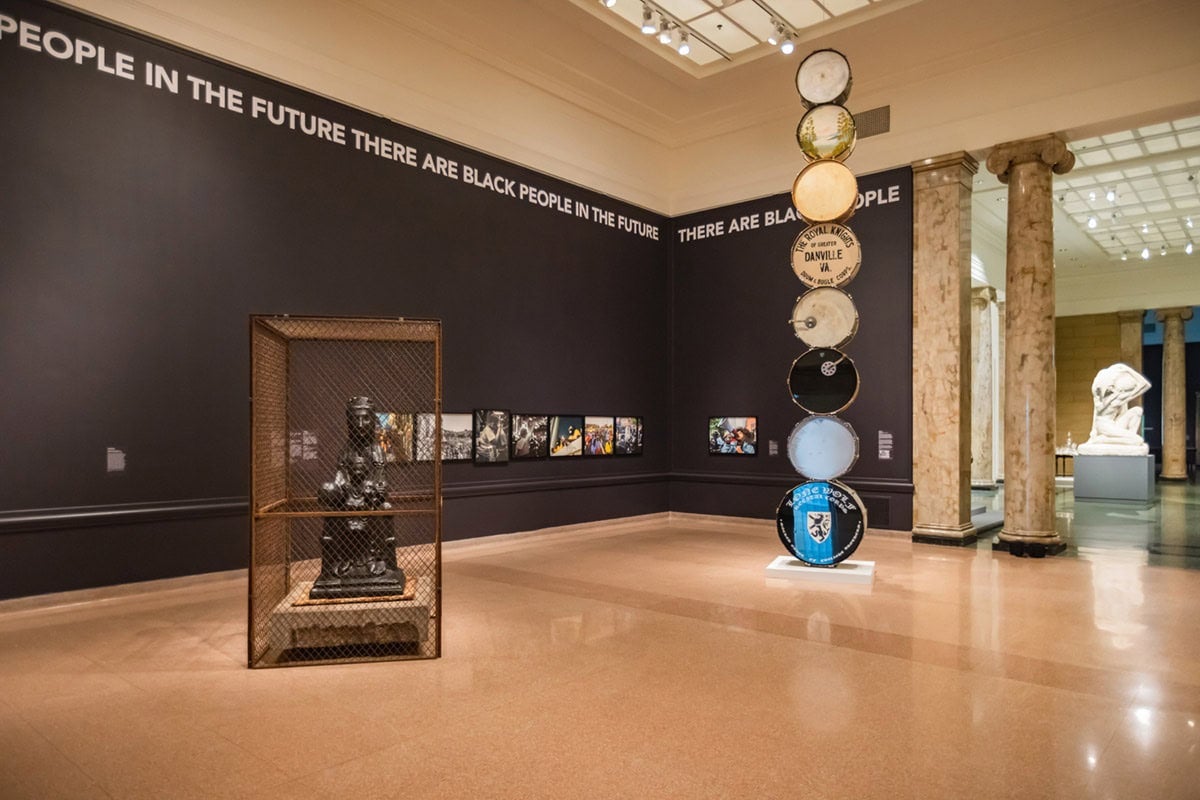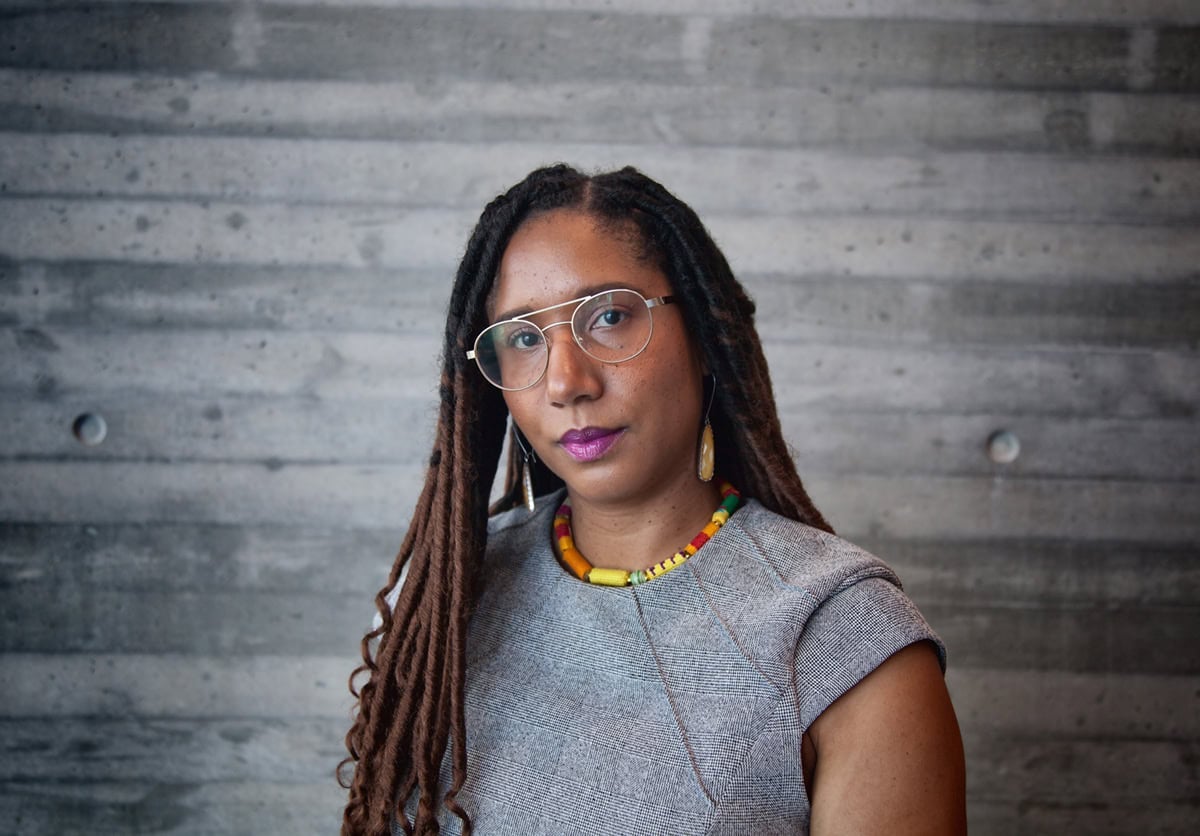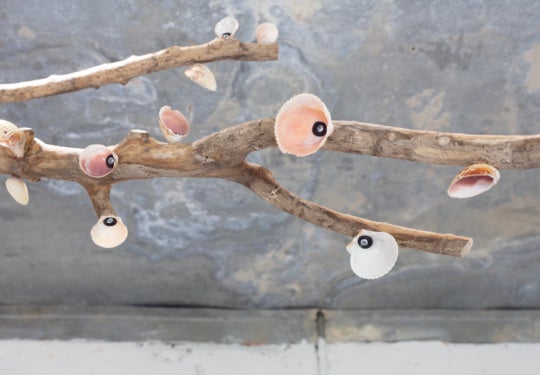
In an untraditional and welcomed move during the planning of Promise, Witness, Remembrance, the Speed Museum tasked their Community Engagement Strategist, Toya Northington to work with a broad base of community stakeholders to inform both the direction of the exhibition as well as all accompanying public programs and events. Northington, trained both as an artist and a social worker, was well-equipped to undertake this effort. She worked tirelessly with two groups: a local Steering Committee composed of artists, activists, mental health professionals, and community members; and a Research Committee tasked with gathering input and feedback from Louisville residents.
Burnaway’s editor, Jasmine Amussen conducted the following interview with Northington in person and over email addressing her personal background, art practice, and experience guiding this monumental project.
Jasmine Amussen: You’re a Louisville native, but spent some time in Atlanta, even as a board member for the then fledgling Burnaway. What brought you back to Louisville? What do outsiders not know about Louisville?
Toya Northington: I came back for a few reasons. First, I needed to be here for my family. My mother and grandmother needed support, and second, I was in a place of transition. I had been working as a fulltime artist for a few years after the housing crisis ended my career as a lighting designer. I wasn’t happy with either at the time. I knew that wanted my art and design to be about more than impressing people or selling things. I was like, “I can use my talent somewhere else, doing something that can help or benefit others.” I just didn’t know what that would be at the time. It was hard leaving Atlanta, and I didn’t plan to stay here. I thought I would stay while I decided what was next, until I found the Kentucky Foundation for Women (KFW). I received several grants for social justice and feminist art projects and was an artist-in-residence for their summer residency at their Hopscotch House. That’s when I conceived my nonprofit artThrust. KFW funded artThrust’s first program and continues to fund my work.
Louisville is family oriented. It’s common to see three or four generations running errands, at appointments, and in restaurants. People who leave usually move back home to be with their family later in life. There’s a strong social justice community and lots of hidden talent across artist genres.
JA: Can you describe your work at the Speed and your own social based practice?
TN: In my day job, I am the Community Outreach Manager. I design, implement and manage all of the community outreach programs and staff including: Speed for All, the free membership program for anyone that wants a membership, but feels cost is a barrier; Community Connections art-based workshops that amplifies the voice of marginalized groups. I also founded the Community Connections Artist-in-Residence through an Our Town, NEA grant. That program allows artists from the West End of Louisville to work within their neighborhood doing art workshops and interventions with other residents about topics and themes they feel is most pressing in their community.
My social practice sits at the intersections of art, mental health, and social justice. I have been using art for healing, empowerment, and to address trauma for about 10 years. First, with teen girls, then with sexual and gender minorities. I find it to be a successful therapy alternative for people that are opposed to therapy due to stigma or personal beliefs, but also a beneficial compliment to other therapeutic practices. I believe in art for art’s sake, but it so powerful for people to be transformed in the process of creating. I am passionate about sharing what I do and using collaboration as the foundation to develop evidence-based practices to inform future art-based services for other practitioners in museums, public health, and those in social work fields to inform their work with marginalized communities in the future.

JA: How different was the work around this project different from your day-to-day work at the Speed Museum?
TN: The main difference in this project from my day-to-day work at the Speed Museum is it was rooted in the life, killing and legacy of Breonna Taylor. I took on this work as a calling that was bigger than me and bigger than the institution. Breonna Taylor means so much to so many people in the Black community that I had to approach everything with her and her family in mind. I also had to be mindful of the greater Louisville communities’ relationship with her, especially the Black community, and needed to make sure their perspectives were represented in the work we created.
The work was also supported by two external committees that I founded and led, the Community Engagement Steering Committee, a diverse BIPOC group with people from various backgrounds and disciplines, and the Research Committee, a professional group of researchers from University of Louisville School of Public Health and School of Social Work and Virginia Commonwealth University School of Social Work. That was the first time I was able to work so closely with others outside the institution. Because we had so many skilled stakeholders working on this project, I was able to cheat time and accomplish things in lightning, supernatural speed.
There Are Black People In The Future is an Afrofuturism piece in the exhibition by artist Alisha Wormsley that invites us to reimagine life for Black people. My role during this project as the Community Engagement Strategist is like an Afrofuturistic story for how to reimage the role that community activism, research, art creation, curating, diversity, equity and inclusion (DEAI) and community engagement could inform how institutions function internally and how we can engage and co-create with other, external communities. The work added a depth to the discussions around the art and the art exhibition itself that would not have been as powerful without our collective feedback. This project asked “what if we do things differently?” What new methods or approached could we incorporate from people outside the institution? By people, I mean the people that have been excluded from those decisions or overlooked in the past. What I found is that we were more efficient, more collaborative, more vulnerable, yet more successful in our outcomes.
JA: The show was put together at lightspeed compared to other museum shows, and focused around such an emotional event. How did you work to ensure you, your stakeholders and others felt safe and rested when moving so fast?
TN: They felt safe, whether they were rested is questionable. Before joining the Steering Committee, I spoke with everyone individually to answer specific questions or concerns. Their identities were anonymous throughout the process and no one knew all the members inside or outside the institution. The committee voted to make their names public. The space was intentionally BIPOC, so people felt we were in a safe and affirming space when we were together and all member were treated with the same value and respect during discussions. Both the Steering Committee and the Research Committee operated with full autonomy. The research also gathered feedback from other BIPOC people in Greater Louisville asking for their feelings about the work that we are doing, and what they would like to see in the programming around the exhibition.
Although we worked during winter break and other holidays, people could cycle in and out if they needed a break. We also created space for others when the content was too heavy, and they needed to step away. They were informed by email or through one-on -one phone calls when they missed meetings, so no one felt left out or punished because they missed a meeting(s).
We are looking forward to getting some rest in June after the exhibition closes. Right now, both committees are still in the middle of planning and promoting closing events and the upcoming PhotoVoice exhibition, It Could Have Been Me.

JA: What outcomes are considered successful for you?
- Tamika Palmer and Breonna Taylor’s family members that visited the exhibition were happy with the exhibition and how it reflected on Breonna.
- I was grateful that we were able to use the exhibition as a platform to reconstruct narratives around Breonna, highlighting narratives rooted in how her family knew as this caring, charismatic, ambitious, fun, loving, young women.
- BIPOC visitors to the museum were able to visit an exhibition where their experiences were seen and affirmed in the space. Many were able to see themselves in the work.
- The exhibition and community engagement work has been presented as a new model for how art institutions can show art that is response to events in the current moment.
- The exhibition created a platform for Black Artists and gave voice to the Black experience that was centered from a Black perspective or point of view.
- The exhibition successfully integrated national and international artists with emergent and local Black artists exposing them to new audiences.
- My institution was able to take a risk and do work that was vulnerable and successful to encourage future explorations in projects that are bold and brave in their intent.
- Lastly, I gained two teams of super stars in my Community Engagement Steering Committee and the Research Committee. Our work will continue after the PWR exhibition to inform social justice and healing projects, research, exhibitions, panel discussions, and arts workshops.
JA: This show is about Breonna Taylor, and her life, and I admit I was nervous that I was going to experience something emotionally violent. Instead, I left feeling positive, even hopeful, maybe. Do you think that feeling can help Louisville, and everyone come to terms with this horror and moving forward?
TN: For me “forward” speaks to positive movement, not stepping back, but advancing to a destination or ahead in progress. This exhibition has been a way to make the invisible, recognizable and intangible, real. It is an emotional exhibition that was bold and direct in its delivery of the truth very much rooted in the Black perspective. What we found is that it allowed not only the Black community to see themselves, but it also allowed others to witness their truth in a way that was self-reflective. It is progress that these things can co-exist. We cannot move on together if we continue to ignore the pain and darkness of our past that influences things happening in the present lives of our fellow citizens. For those of us that have experienced the trauma of racism, violence and/or inequity, we cannot heal or organize against injustice if we cannot find ways to process our feeling towards the things that hurt us in healthy ways. This exhibition provided the platform to do both.
Time will tell if displaying these truths in the exhibition were the first steps to allow people to process what they or others have experienced and how that affects everyone’s quality of life and the wellbeing. It was also a step forward for art activism and art as social practice. This work allowed people to feel something they would not have experienced in any other way or space. That emotion is the beginning of change. It is the recognition that something important happened with the next step being “what will I do about it?” Time will tell what we, as a community and others, do to respond to it.
Promise, Witness, Remembrance is on view at the Speed Museum in Louisville, Kentucky through June 6, 2021.
This interview is part of Burnaway’s week-long coverage of the exhibition.




